Are you looking for a wonderful hiking – but not only – destination? Welcome to El Ripollés, our favourite part of the Girona Pyrenees. Here’s all you need to know about the region – all the best things to do in El Ripollés, and best hikes!
In October 2017, we spent a month in the province of Girona, hiking the GR1 and writing our first eBook – free to download on the Costa Brava/Pirineu de Girona website!
Day after day, as we hiked from the coast to the mountains, we saw the landscape change. Coastal forests gave way to agricultural landscapes, which in turn led us to the hills, and finally the mighty Pyrenees.
As much as we loved the GR1, we left with the feeling of not having gone deep into the mountains. The maximum altitude we reached was only just over 1000 meters – from where we stood, we could see mountains stretching into the distance, and we made each other a promise.
One day, we would be back to hike more.
Fast-forward exactly two years, we did make it back! Over the course of two weeks, we explored two different regions – El Ripollés, including the town of Ripoll and some of the best hikes in the Girona Pyrenees, and Alt Empordà, famous for its wine and rugged coastline, finishing up with three wonderful days in Cadaqués.
Here’s our guide to El Ripollés – including the best things to do in Ripoll, plus Medieval towns, sights, and the best hikes all over El Ripollés!
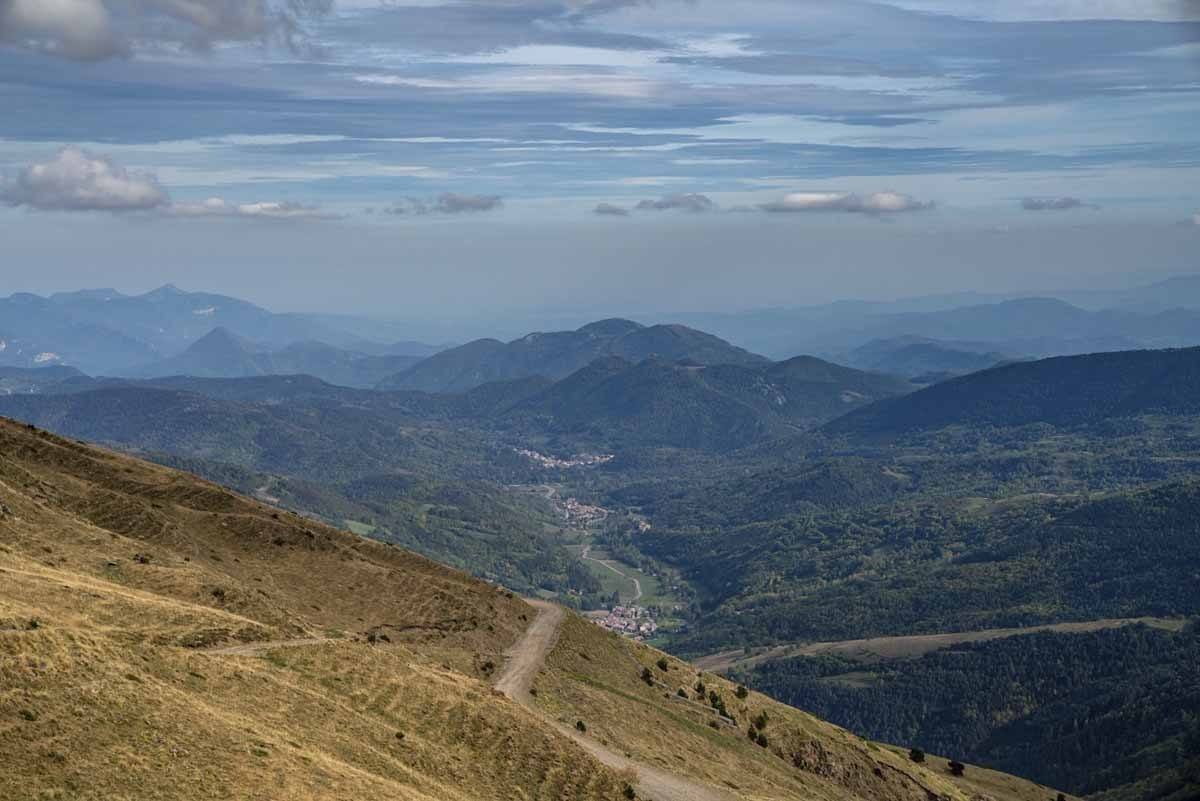
What to do in Ripoll
Walk Along The Rivers
Yes, I actually meant to say the riverS! Ripoll is located at the confluence of two rivers, the larger Ter and the Freser, its tributary.
The power of these two rivers descending from the Pyrenees, plus the abundance of coal and iron in the surrounding mountains, gave rise to a flourishing metal working industry ever since the Middle Ages. There’s little left of the industry nowadays – to know more, visit the Ethnographic Museum.
Walking along the two rivers and through the historic centre is a fun way to kill the time in Ripoll. The most notable bridges are found along the Ter – a modern white bridge designed by none other than Santiago Calatrava, and a modern bridge-cum-passageway built in the vacant lot where the former La Lira theatre once stood.
Visit the Monastery of Santa Maria
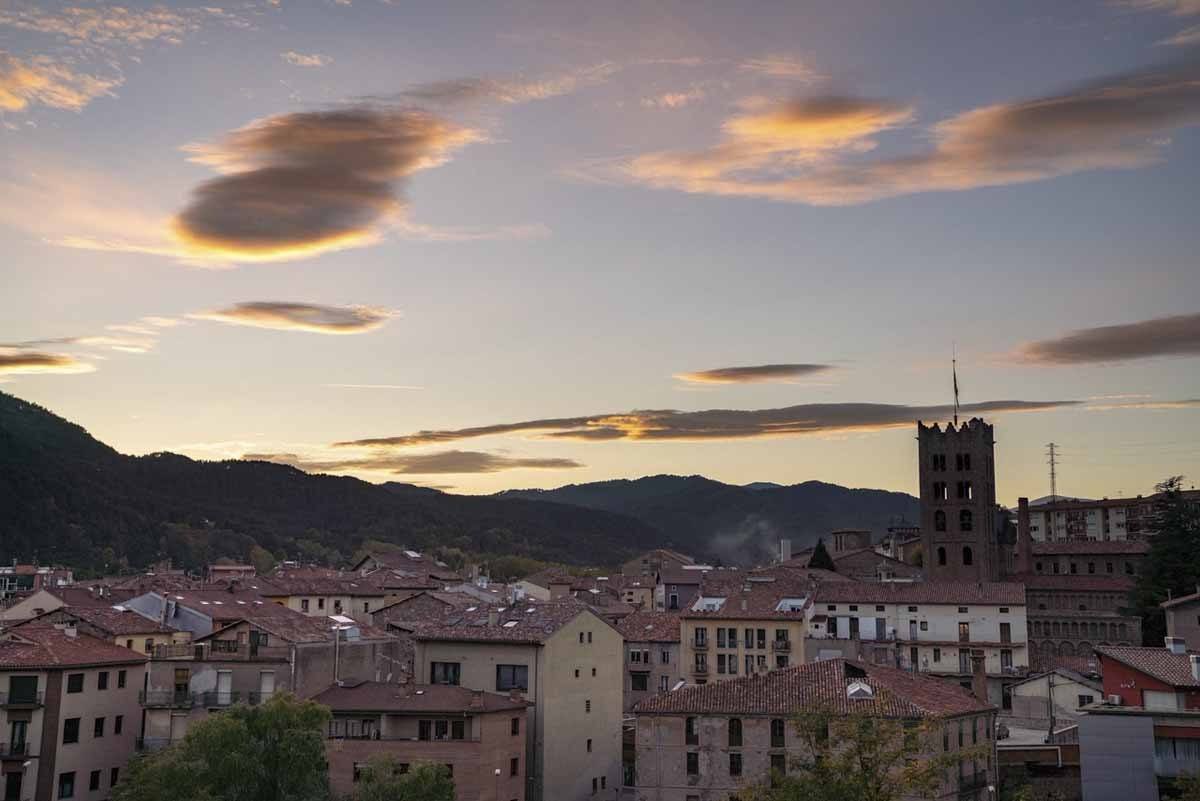
Around the year 1000, Ripoll was a bustling town thanks to the Monastery of Santa Maria de Ripoll, its adjacent monastic school and scriptorium.
The monastery still stands proud, overlooking the main square of the town. The entrance portal is all that remains of the original Romanesque building, after a fire destroyed it in 1835. Most of what you see was rebuilt in the latter part of the 19th century.
Nowadays, the #1 unmissable thing to do in Ripoll is visiting the Monastery of Santa Maria. You get a handy interactive guide on an iPad, which you can use to guide yourself through the church and cloisters.
The highlight of your visit will definitely be the portal, intricately carved with biblical images – including the Four Evangelists, Twenty-Four Elders, and stories from the lives of Moses and Solomon.
Learn about Pyrenees Life and Culture at the Ethnographic Museum
If you only have a day or so in Ripoll, after visiting the Monastery you’ll only have to walk across the square to find the next attraction – the Ethnographic Museum.
This is a must for anyone interested in the history and life in El Ripollés in the past – between agriculture, transhumant shepherding in the Pyrenees, and the rise and fall of metal work industry in the city.
You’ll find diorama and curious objects on display, like wooden collars used to protect animals from wolf attacks, and porró, the unusual glass pitcher used to drink wine in Catalunya.
Most of the descriptions are in Catalan, so if you’re not familiar with the language we recommend going with a guide.
Learn Medieval Calligraphy at the Scriptorium
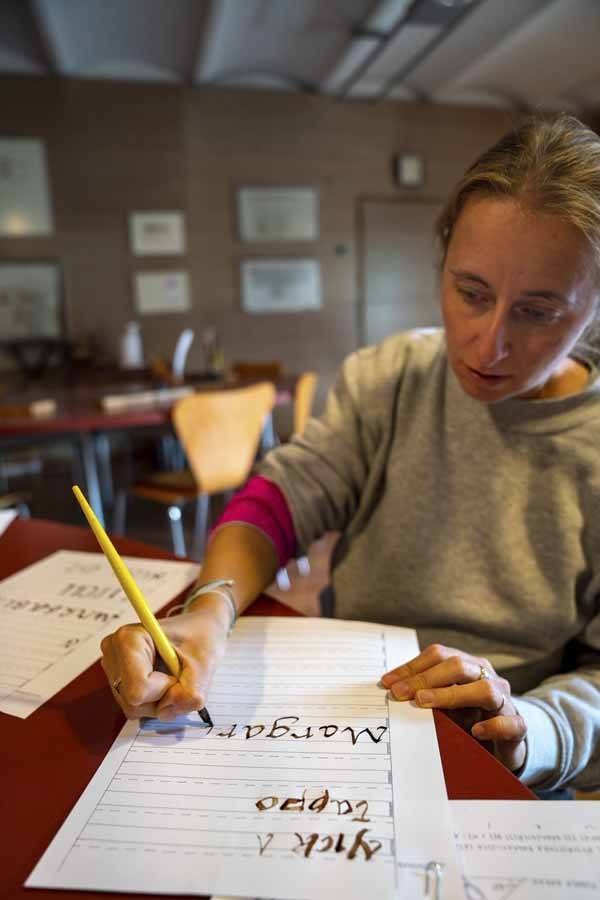
Remember how I said that in the Middle Ages, the Monastery of Santa Maria and its scriptorium were a hive of activity? In the Scriptorium, between the 10th and 13th century, monks and novices copied by hand thousands and thousands of bibles and other sacred texts.
These books were real works of art – they weren’t just written one by one, letter by letter, but also decorated with illustrations and ornate capital letters at the start of each chapter. Before the invention of the printing press, this is how books came to light.
The Ethnographic Museum of Ripoll decided to honour the glorious past of the town’s Scriptorium by opening a brand-new attraction – another unmissable thing to do in Ripoll.
In the ‘modern’ Scriptorium, visitors can first see an exhibition about Medieval manuscripts, their history and technique, and then they can try their hand at practicing calligraphy.
The result will be a bookmark, your very own souvenir to take home!
Visit a Secret Modernist Chapel
In Ripoll you can also visit the chapel of Sant Miquel de la Roqueta, built in 1912 by Joan Rubió i Bellvé, a disciple of the great Antoni Gaudi.
The chapel is hidden in a backstreet not far from the Scriptorium. It’s not on Google Maps and during our 2017 visit we couldn’t find it – this time we did. It’s a curious sight, surrounded by modern buildings!
Things to do in El Ripolles
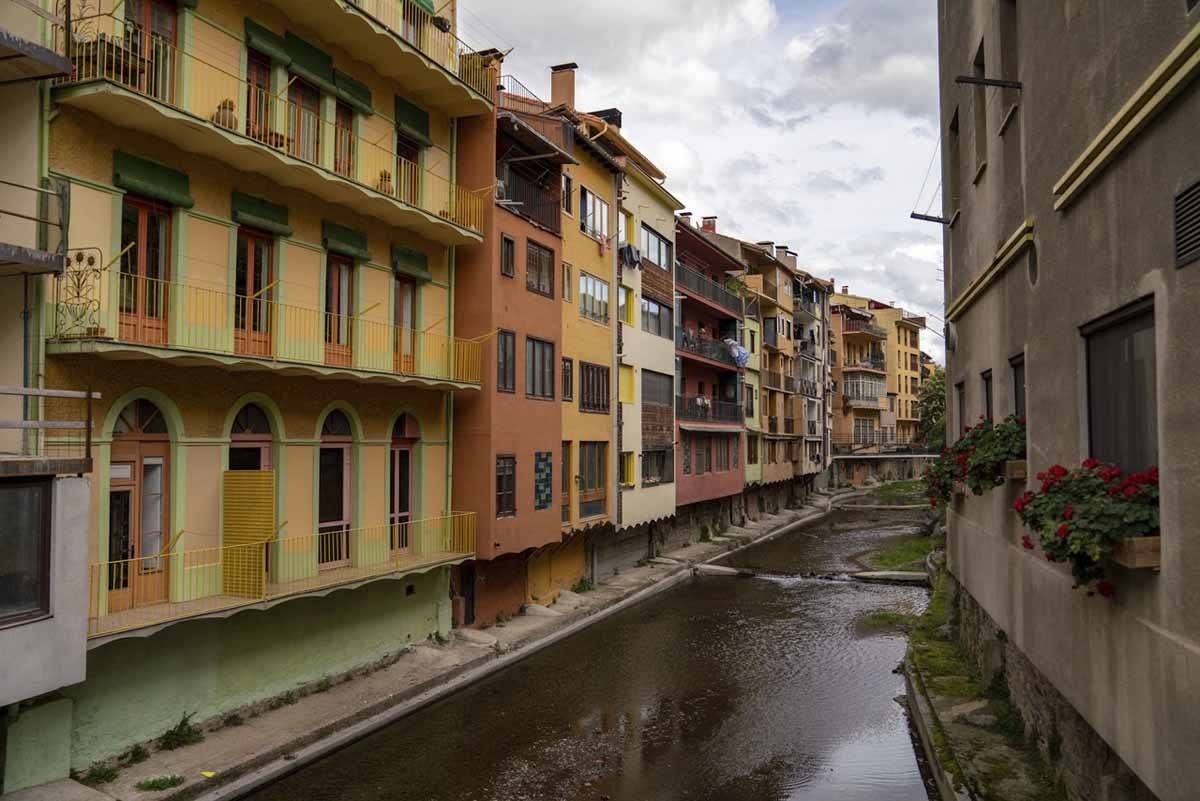
Ripoll is a lovely base to spend a day or two, but the real marvels of El Ripollés can be found in the surrounding region – there are mountains, ski resorts, forests full of surprises and chance encounters, medieval towns, monasteries in the mountains, and a lot more.
These are some of our favourite places and activities around El Ripollés – for more inspiration, here’s our article on places to see along the GR1!
Walk Around Camprodon
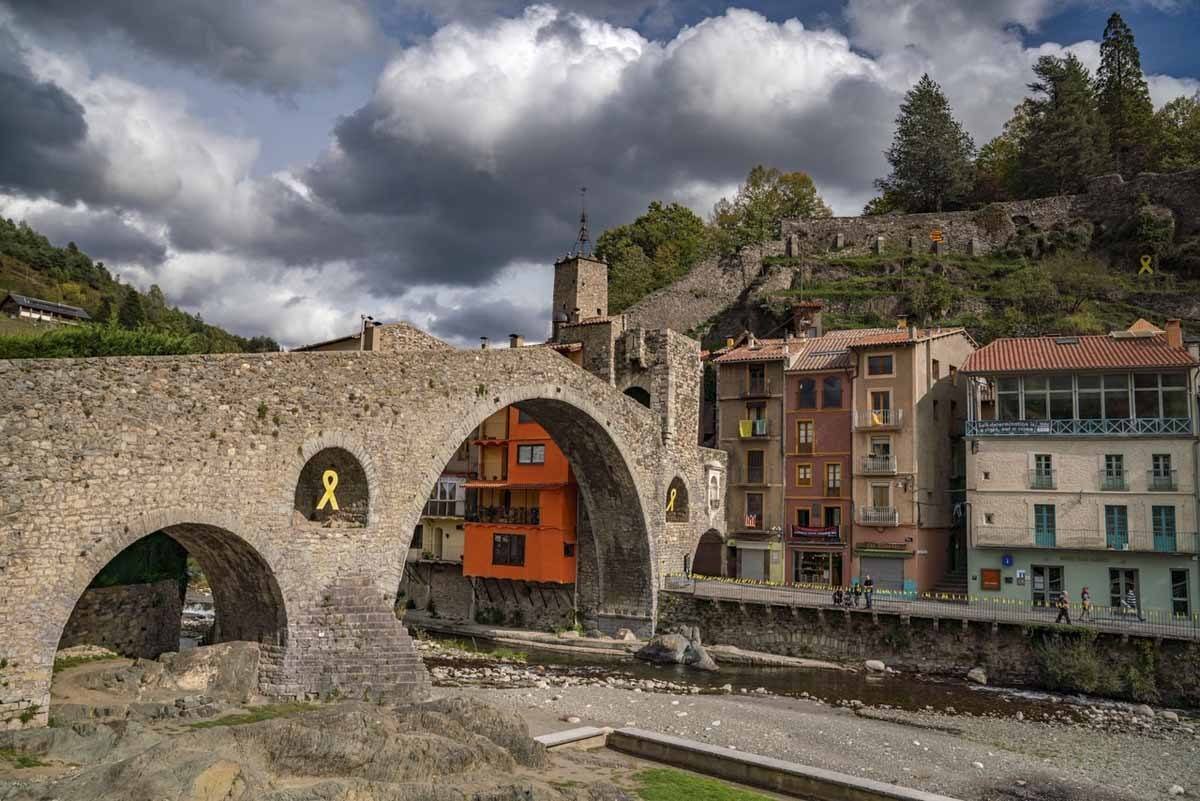
Have you ever walked across a town and thought ‘wow, I wish I could stay here longer?’ This was Camprodon for us. It was the final stage of one of our hikes, and we spent about an hour wandering through the city before heading back to our hotel.
Similarly to Ripoll, Camprodon is located at the confluence of two rivers – the Ter and the smaller El Ritort stream. The most notable sight in Camprodon is the 12th century Pont Nou, a slender Romanesque bridge over the Ter.
On the other side of the bridge there’s a colourful historic centre, with narrow pedestrian streets and some interesting historic shops. I’m still dreaming of the candied almonds I ate there!
It’s also possible to visit two Romanesque churches, Santa Maria and San Pere, and two interesting museums – one dedicated to local musician Isaac Albéniz, and La Retirada, about the Spanish Civil War.
Have Lunch in Beget
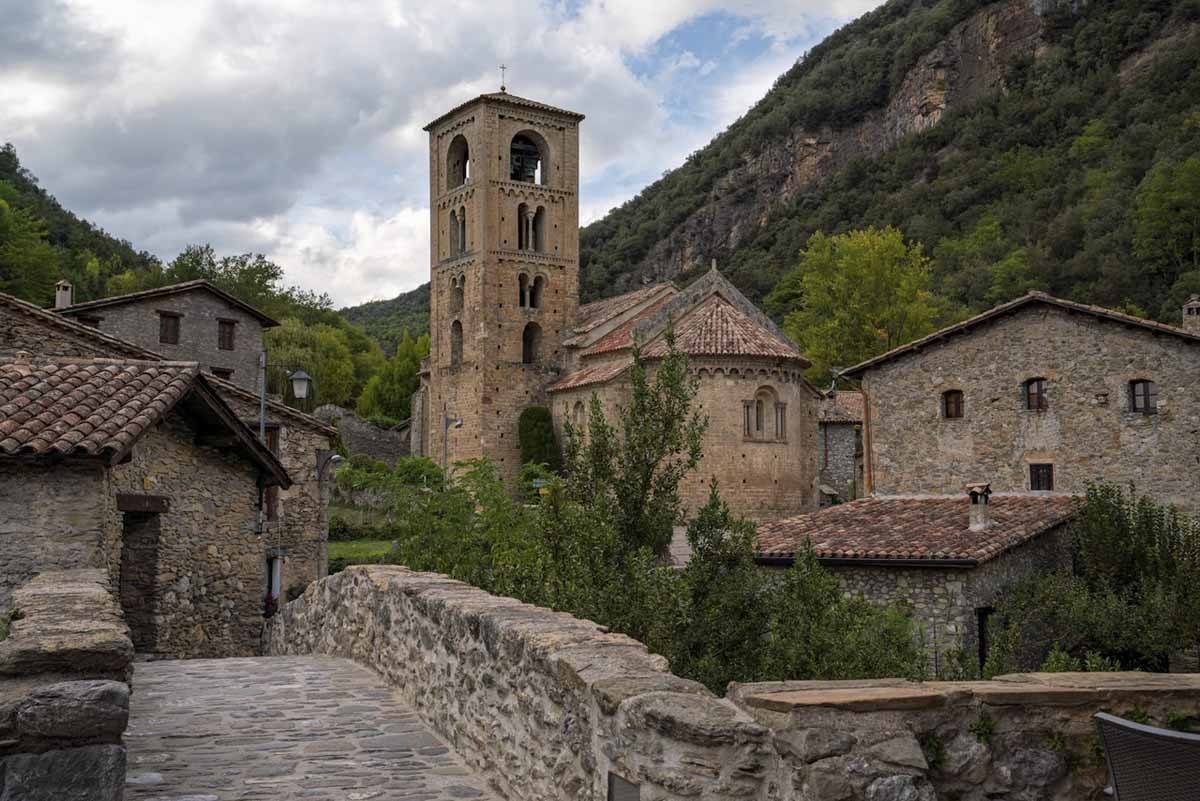
Beget is not a place you end up at by mistake. Our driver called it ‘el poble a la fi de l’món’ (the village at the end of the world) – you reach it at the end of a long, twisty mountain road, at the bottom of a valley with no phone signal.
This road was only built in the 1960s, and when it snows in winter, it’s not ploughed – meaning that the village is effectively cut off from the rest of Catalunya.
Beget is a wonderful place for a half-day trip. It’s one of those super cute medieval villages – complete with narrow streets, a bridge and a series of picturesque corners, all surrounded by the Pyrenees.
Two places in Beget are worth mentioning – the Romanesque church of Sant Cristòfol, worth visiting for its 14th century alabaster altarpiece and wooden statue of Jesus Christ, and Can Jeroni Restaurant, serving Catalan favourites with a twist.
Visit the Monastery in Sant Joan de les Abadesses
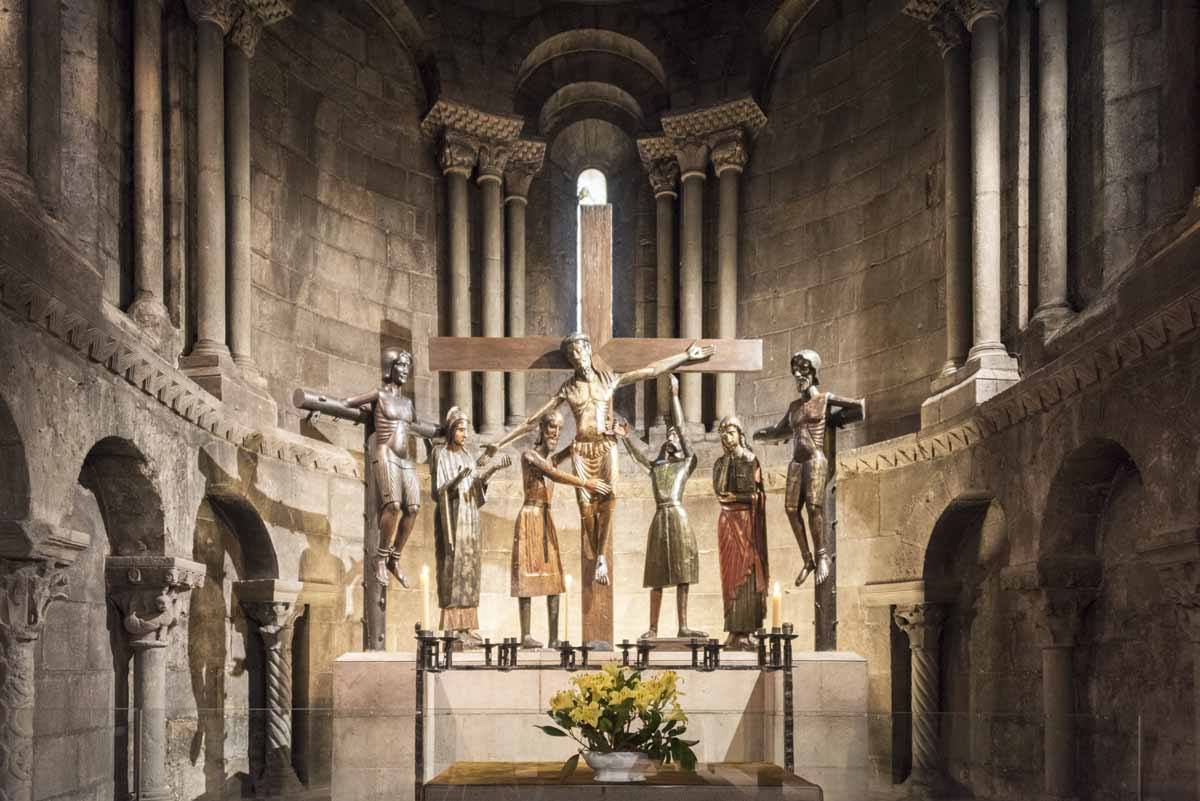
If you like medieval architecture and old bridges, there’s another place in El Ripollés that’s worth visiting – Sant Joan de les Abadesses, only a short drive away from Ripoll.
The main sight in town is the Monastery, the only nunnery in the region, established in the 9th century and after which the town took its name – ‘abadesses’ refers to the head nuns that ruled the monastery for centuries. You can visit the Monastery, the two-storey Gothic cloister right next door and adjacent museum.
After that, walk out of the historic centre towards the river to admire the Pont Vell, first constructed in 1138 but rebuilt again in the following centuries. The ‘new bridge’ just next to it provides the perfect vantage point.
Have ‘Dinner with Deers’ in Gombren
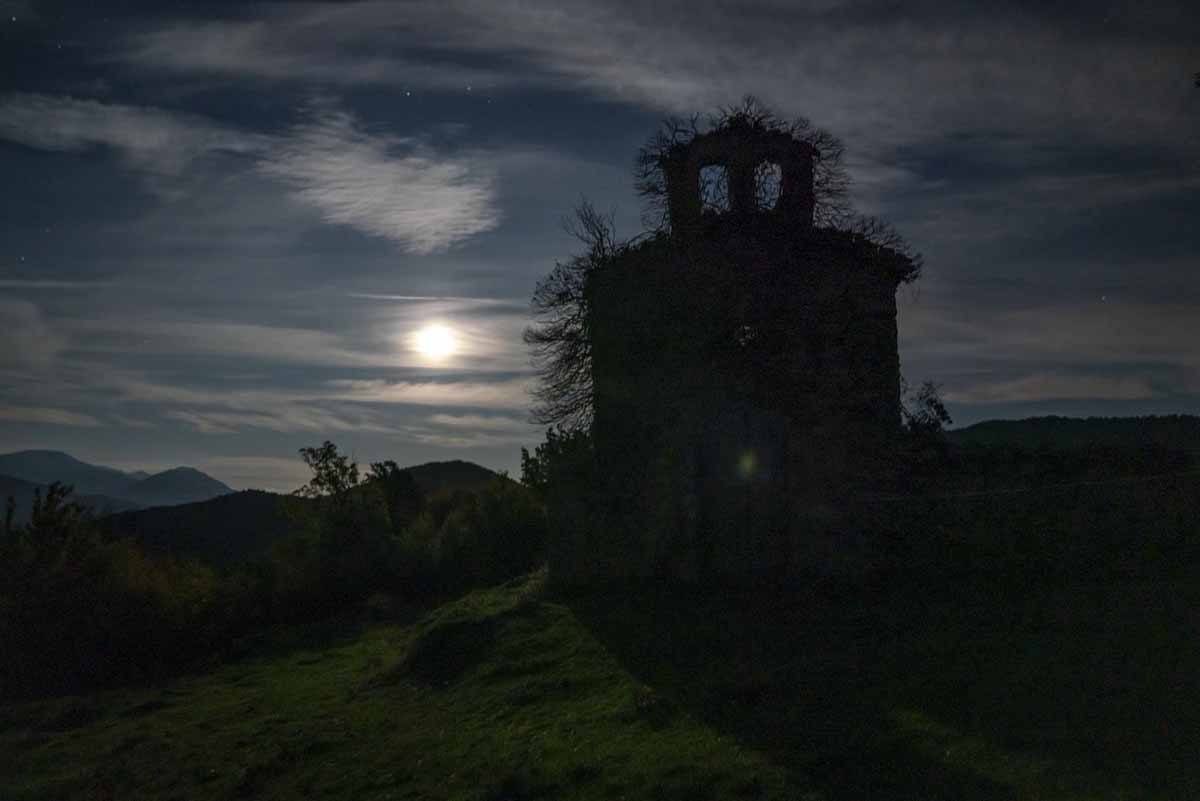
El Ripollés is not just about Medieval history, churches and bridges – it’s also a place where you can enjoy nature at its true, wild best.
If you’re visiting in September/October, we recommend heading to Turisme Rural La Canal near Gombren for ‘sopar entre cervols’, meaning ‘dinner with deers’, a really unique experience taking place during deer mating season.
No, you won’t be eating deer – you’ll be hiking under a starry sky accompanied by a naturalist guide, listening to the mating call of deers. Trust me, you won’t have to hike far – we heard our first call only moments after leaving the front door!
The experience lasts a couple of hours, and includes a presentation about wildlife in the Pyrenees, followed by the hike and home-cooked dinner at La Canal. If you can, we also recommend spending the night – we did, and fell asleep listening to the deers’ calls!
Go Skiing
In Winter, El Ripollés becomes a popular skiing destination. Two of the best-known resorts are Vall de Nuria and Vallter 2000 – at the time of our visit in October, they were both closed as there was no snow, but you’ll typically find them open between December and April.
Best Hikes in El Ripolles
Here we’ve collected our 5 favourite hikes around El Ripollés, a good mix of easier and harder hikes. To know more about hikes in the region, head over to the Itinerannia website, including a huge database of hikes around El Ripollés, Alt Empordà, and Garrotxa.
The Itinerannia network includes over 2500 km of trails, all very well signposted, with yellow marks showing you the way when there are no signs. On the website you’ll find a variety of routes, each with their own description – you can filter them by geographical area, length, and difficulty level.
There’s also a handy route planner section, with instructions on how to create your personal itinerary, including the points of interest you wish to visit.
Hike Up (or Down) Vall de Nuria – 13.7 km/5 hours 30
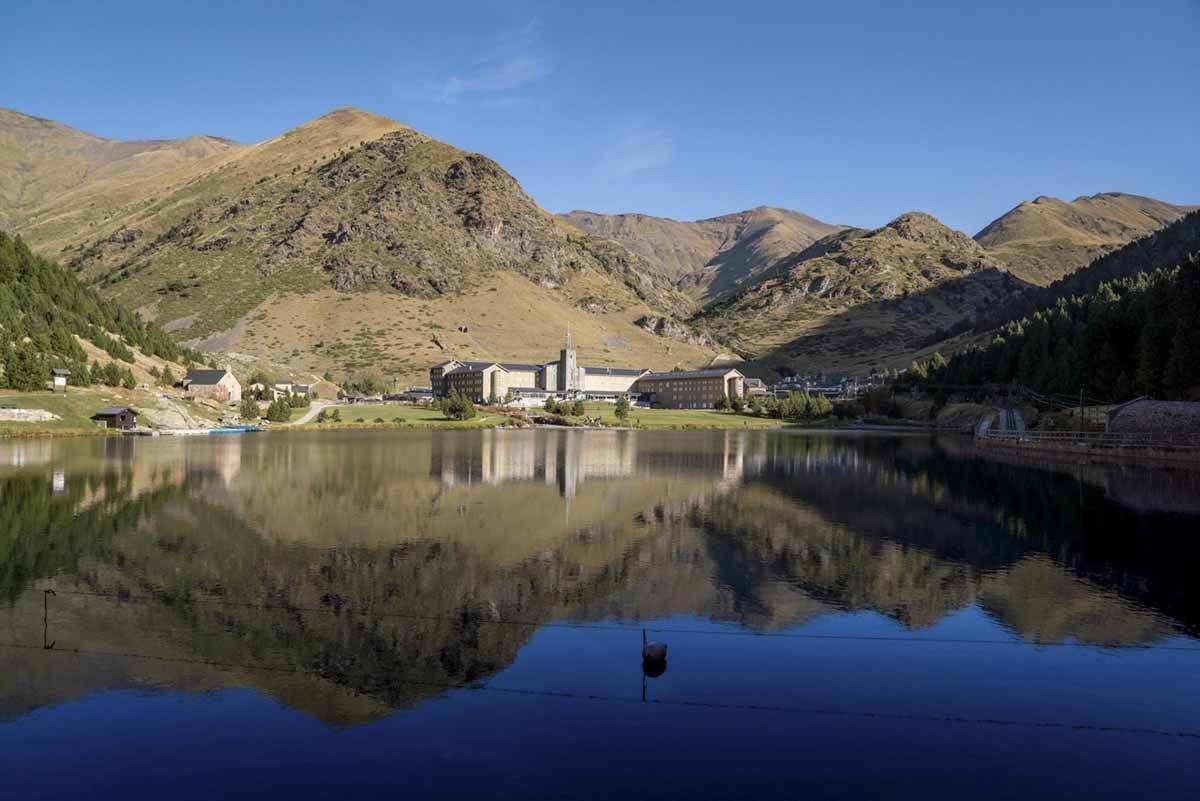
Do you only have time for one hike in El Ripollés? Then, make sure you visit Vall de Nuria and its beautiful sanctuary, part of the Capçaleres del Ter i del Freser Natural Park.
If you don’t fancy hiking up, you’re in for a treat – you can easily reach the sanctuary by rack railway from Ribes de Freser at the bottom of the valley, and then hike down.
The rack railway takes approximately 35 minutes to cover the 1000-meter elevation difference between Ribes de Freser and the Vall de Nuria sanctuary, at 1964 meters above sea level. Before the railway was built in 1930s, the only way to reach the sanctuary was on foot.
If you take the train up and hike down, start with a visit to the Sanctuary. It is a very important place for Catalan people, and has been a popular pilgrimage destination for over 1300 years, with visitors from both sides of the Pyrenees.
The Sanctuary is dedicated to the Virgin of Núria. There’s a wooden statue of her located inside the church – many couples visit, as praying to the statue supposedly helps couples with infertility problems.
After visiting the Sanctuary, it’s time to start hiking down. Before that, walk around the lake and climb up to the viewpoint to see the Vall de Nuria sanctuary from above – hopefully, you’ll be as lucky as we were with the weather!

Then, keep hiking down following a gorge created by the river Freser. The railway runs on the opposite side of the gorge, surrounded by rocks and waterfalls. It’s a really beautiful place, and in summer it’s also possible to go canyoning.
About an hour and a half into the hike, the first trees appear, signalling that you’ve climbed down to about 1500 meters above sea level. The more you descend, the more even and less steep the path becomes – after another half an hour, you’ll see some stone house and finally you’ll enter Queralbs, marking the end of the natural park.
In Queralbs, you can choose to take the train to Ribes de Freser, or hike a further two hours following the Ruta de Las Centrals, through the forest and past some early 20th century hydroelectric power stations.
Hike from El Baell to Montgrony Monastery and Gombrèn – 17 km/7 hours
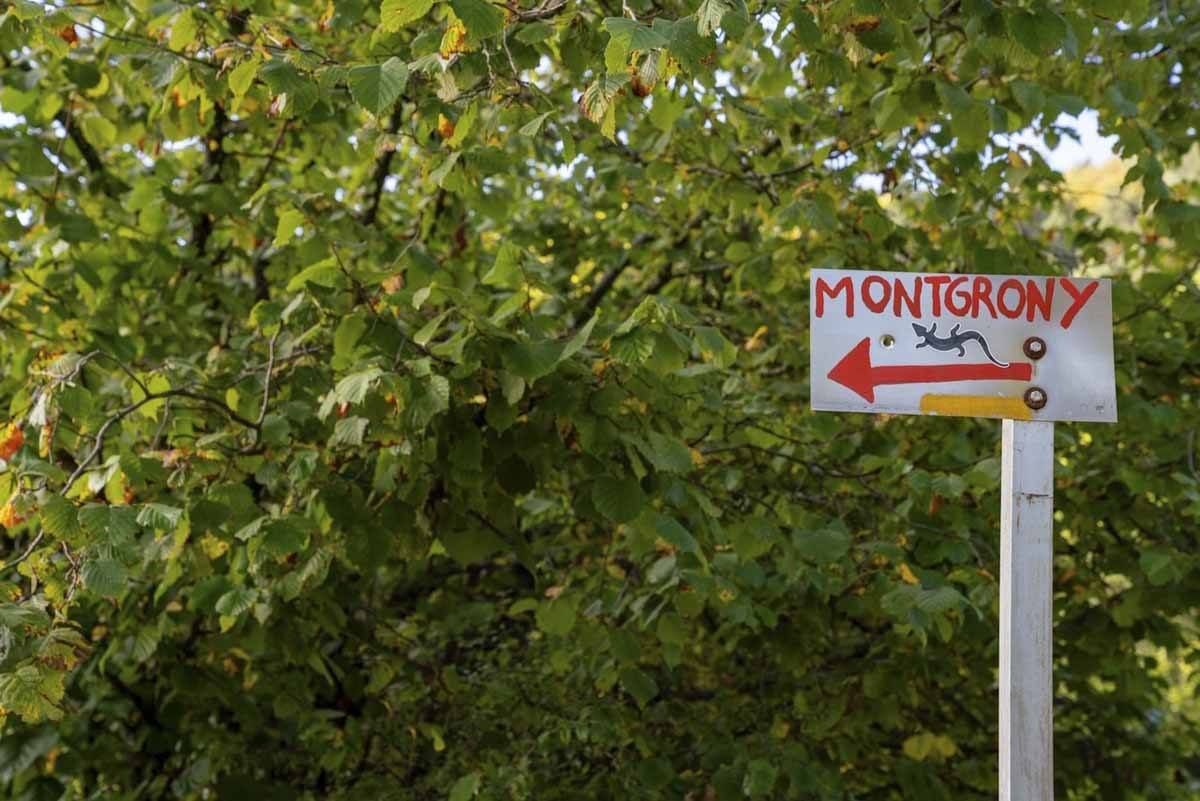
The highlight of this hike is the stunning Montgrony Sanctuary, built in the 15th century amidst the limestone crags overlooking the Vall de Gombrèn.
The easiest way to reach it is from Gombrèn, from where it’s a steep 1 hour and a half climb. Alternatively, you can do as we did and hike to Montgrony from El Baell, stop at the monastery for lunch and then continue all the way to Gombrèn, to avoid backtracking.
El Baell is a small hamlet at about 1500 meters above sea level. The first part of the hike is largely flat, with only some small ascents and descents, through a mixed coniferous/deciduous forest. We hiked it surrounded by the boira, the mist of the Pyrenees, which lent the whole landscape a magical, otherworldly appearance.
After about three hours, the path circles around a mountain then started climbing up, getting steeper and steeper through the forest. Finally, you’ll see the destination – the Monastery, hugging the mountainside, with a small church, a restaurant and a pilgrim’s alberg.
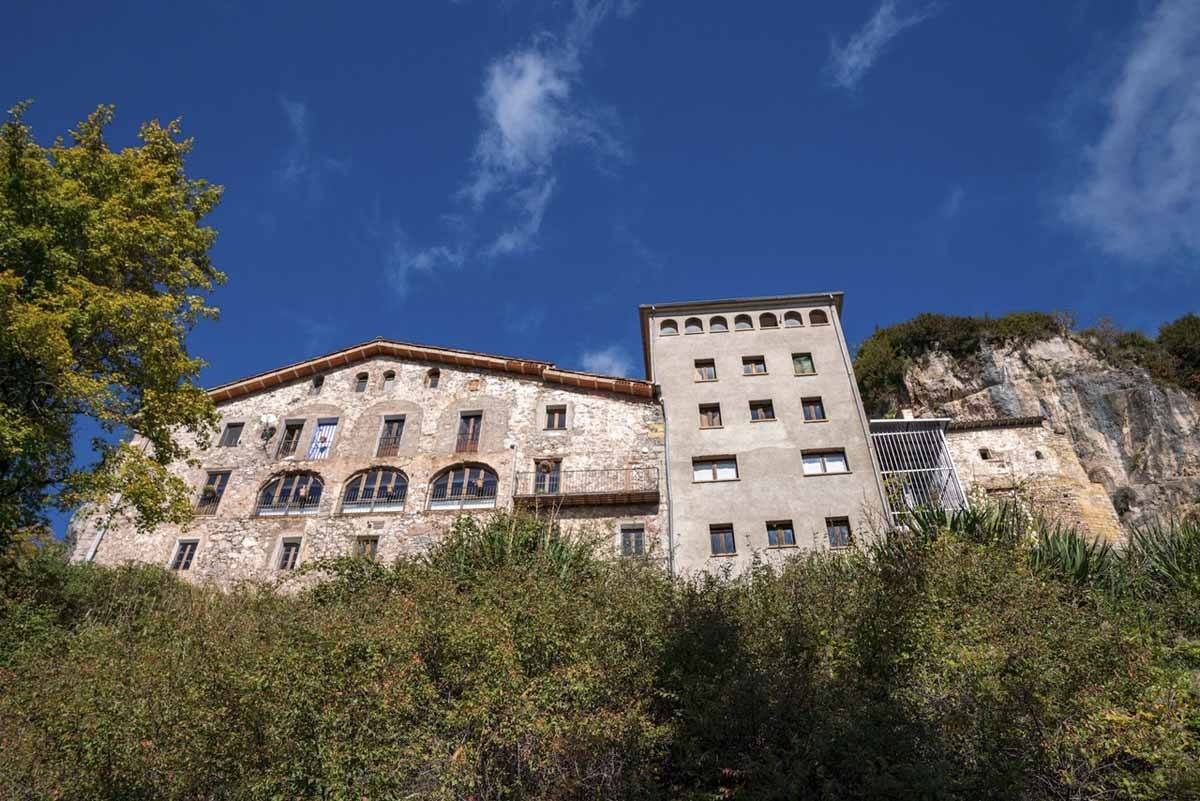
According to a local legend, the Monastery was built by the Comte Arnau, an evil nobleman from El Ripollés who is condemned to ride for eternity on a horse engulfed by flames. You’ll find references to Comte Arnau in many places in the region – if you want to know more, there’s a dedicated museum in Gombrèn.
Make sure you have at least a couple of hours to explore the Sanctuary, to visit the church and chapel inside and outside, and to take in the wonderful views over the Vall de Gombrèn. You can end your hike here, or keep going a further hour and a half all the way to Gombrèn.
Hike to Ripoll along the Camí Ral – 16.4 km/4 hours
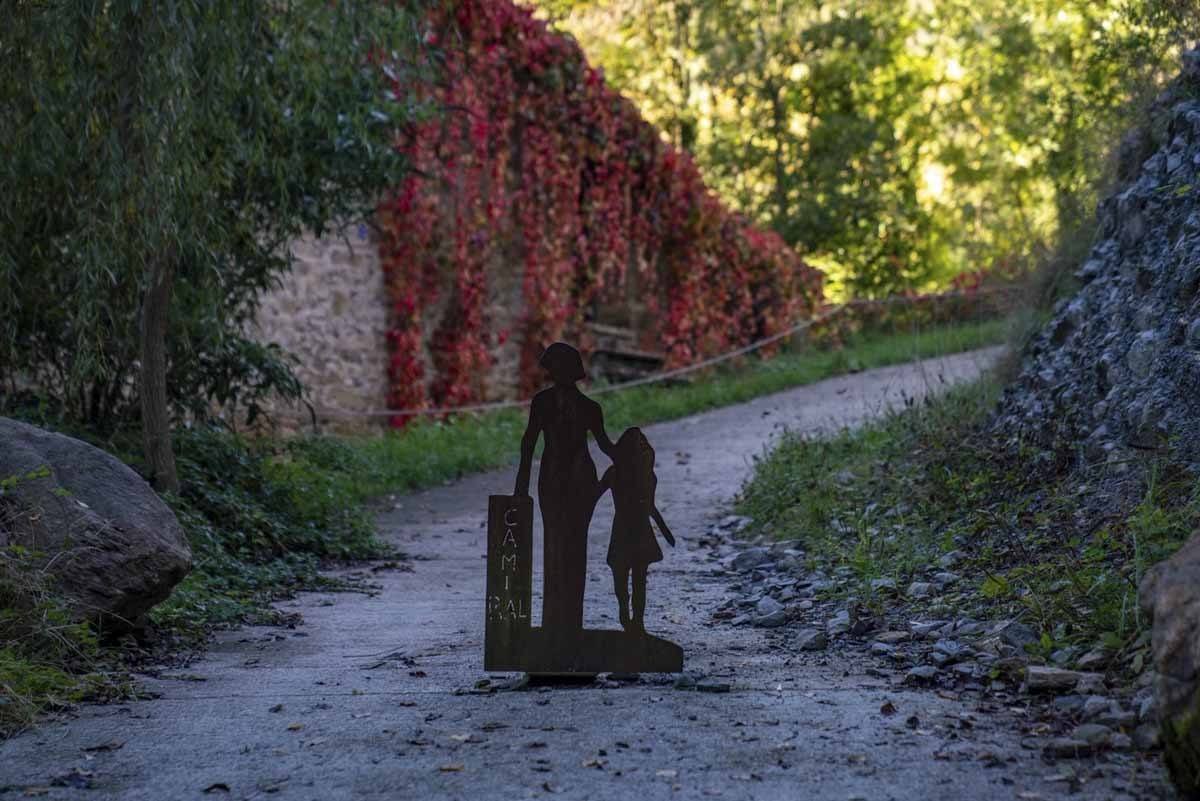
After two fairly challenging hikes, it’s time for an easy one! This itinerary starts at Turisme Rural La Canal, where you can enjoy the wonderful ‘dinner with deers’ experience described above. Alternatively, you can start in Gombrèn – in that case the hike will be approximately an hour shorter.
The first part of the hike is pleasant, shady and offbeat. The path is easy and wide, almost entirely through a forest, with not much in terms of ups and downs.
The peaks of the Pyrenees will get further and further away from you. After an hour, you will reach Gombrèn and take the Camí Ral, a royal path dating back to the 18th century, when it was the main way to travel between cities. ‘Ral’ means royal, because by decree, all paths connecting villages were to belong to the crown.

The Camí Ral is 4.8 km long, and connects Gombrèn to Campdevanol. It’s very well signposted and easy to follow in about 2 hours. Most of it runs along a river, and you’ll pass springs like the Fonte de Sant Eudald, said to have miraculously appeared from the ground when the saint passed here.
It’s a nice, easy hike, but it’s a lot different from the other two described above – there’s not much in terms of elevation change, and you’ll feel as if you’re walking in the countryside rather then mountains.
In Campdevanol, we recommend stopping for lunch at S’ha Acabat el Broquil, a cool local restaurant offering an excellent value lunch menu. Just don’t ask for broccoli – the restaurant’s name can be translated as ‘we finished the broccoli!’
From Campdevanol, there’s a path running along the Freser river, leading you to Ripoll in about 45 minutes.
High Pyrenees Hike from Vallter 2000 to Tregura de Dalt – 20 km/8 hours
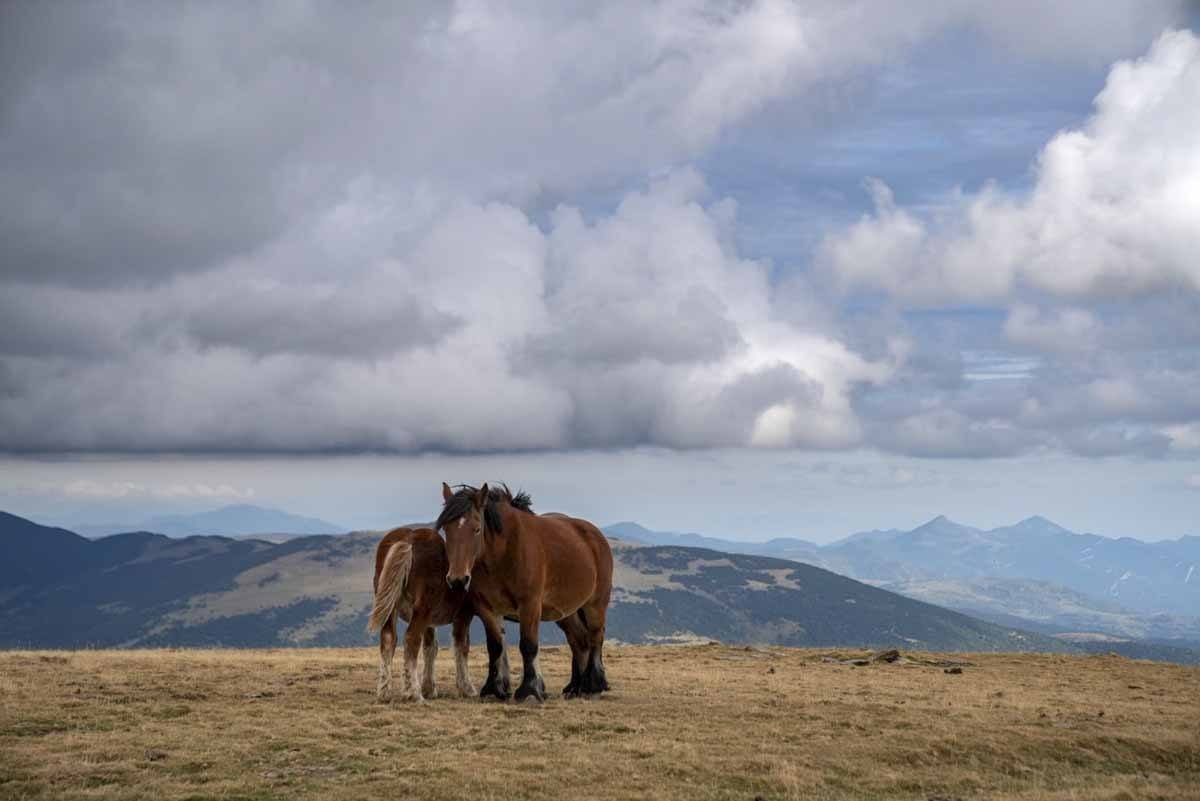
This is the most challenging of all the hikes in El Ripollés described in this article. It’s long, steep and at high altitude – you’ll be crossing two mountain passes at 2500 meters above sea level.
The hike starts at the Xalet (lower) car park in Vallter 2000, a ski resort, dead quiet in mid-October. You can actually join the trail from the ‘intermediate’ car park as well, saving yourself 10 mins uphill walk. Since today there’s a lot of uphill to be done, it’s good to have a shortcut!
First, head towards Rifugi Ulldeter. The trail is steep, heading up towards the end of the tree line. When we visited in October, the forest was changing colour, with yellow trees here and there, and warm autumn light filtering through the clouds.
Then, the forest ends and you’ll find yourself hiking in the open, with the air getting colder and the path getting more and more rocky the higher up you get. At this stage, the trail coincides with the GR11, the Great Pyrenees Crossing.
After the first pass, the trail descends alongside a stream. This is probably the most pleasant part of the day – it takes approx 1 hour and a half to reach Refugi Coma Da Vaca, easy to recognise as there are plenty of cows outside.
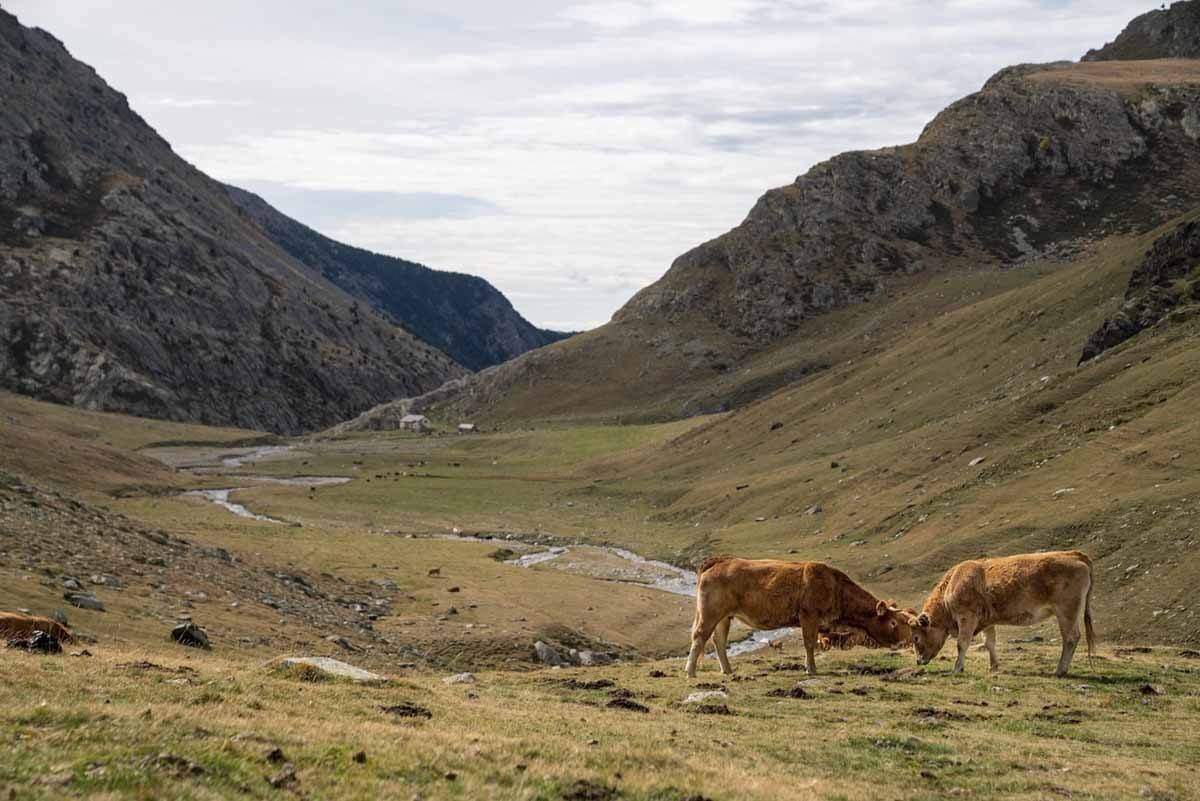
Don’t cross the stream towards the refugi, as it’s not open. Stay with the stream on your right and turn left towards the pass right ahead of you. Your destination, Tregura, is marked as being 4 hour ahead.
Here, you’re no longer on the GR so you just have to rely on yellow marks – but we couldn’t find many, so we just followed our GPS. The trail loops back towards where you came from, presumably to avoid steep sections.
Follow it – it ascends to the second (and last) mountain pass, in about an hour. This climb is even harder then the one to the first pass, but the landscape is also even more beautiful.
The day we did this hike, we felt as if we were standing on the edge of the world. There was not a soul to be seen, only a stark landscape of stacked clouds, scorched grass, grey rocks. Mountain tops floated in the distance, between clouds and horizon, dissolving into the sky.
We followed the trail descending gradually – the wind was sharp, ruffling the mercury-coloured waters of a tiny mountain lake. Right next to it stood a pregnant horse with her foal from the previous year. A lovely image of motherhood, we thought.
From the second pass, it takes about two hours to reach Tregurà de Dalt, following a mountain road descending with a series of switchbacks. There are actually two hamlets called Tregurà – ‘de Dalt’ is the higher of the two, ‘de Baix’ is located just below.
Hike Tregura de Dalt to Camprodon – 14.5 km/5 hours
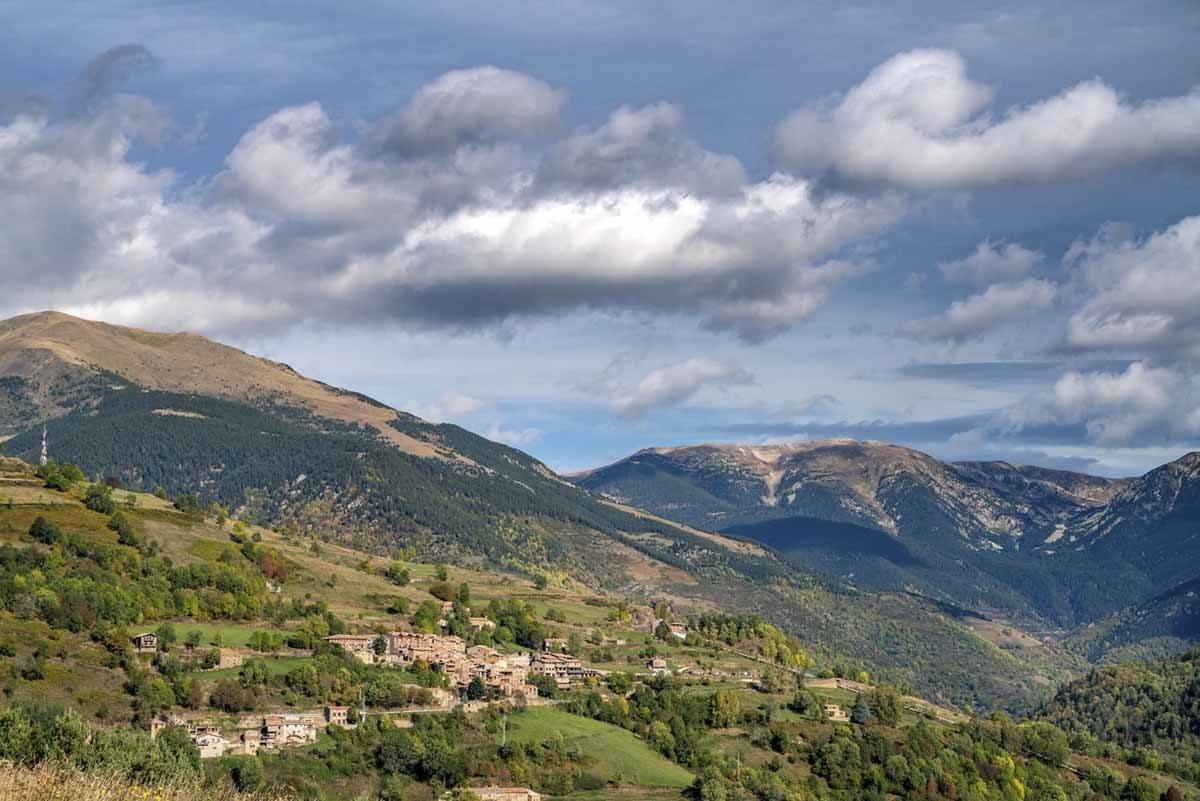
The last in this list of hikes around El Ripollés is nice and easy, alternating some moderate climbs through forests to easy paths along rivers and through Medieval towns.
First, walked down the road for a bit to Tregura de Baix, until you enter an oak and pine forest. We saw cows grazing freely. The path starts ascending and every now and then, beautiful views will open over the valley, offering a great vantage point to see the ‘two Tregurà’ surrounded by the mountains – streaked with autumn at the time of our visit.
After reaching the top, it’s time to descending towards Vilallonga de Ter. The path cuts across fields on the mountainside and runs along a fence, until reaching the village with a pretty Romanesque church and kids playing in the street.
Then, it’s time to continue. The path runs parallel to the river Ter – you’ll be leaving the high mountains behind and entering a more ‘urbanised’ environment, with runners, people walking dogs and pushing children on strollers.
From Vilallonga onwards, the path runs along the river crossing a series of hamlets, before reaching Camprodon, your destination. The first hamlet is La Roca, a smattering of stone houses surrounding a rocky peak – there was not a soul to be seen, just three dogs napping on a balcony.
Then you’ll reach Llanars, where the river Ter creates a small waterfall. Don’t enter the village but keep following the path along a river – in just under half an hour you’ll be in Camprodon.
We would like to thank the Patronat de Turisme Costa Brava Girona for having welcomed us again. Moltes gracies Dunia! Many thanks to Itinerannia for putting together such a wonderful itinerary for us!
